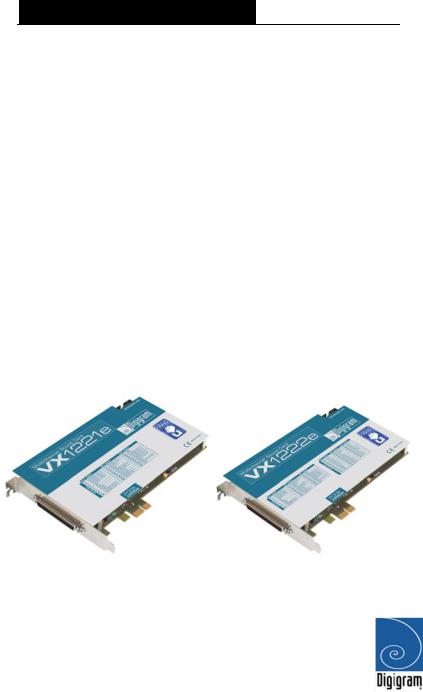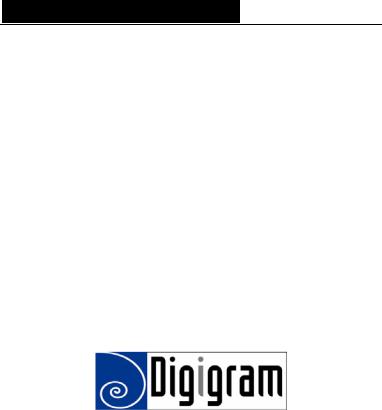Digigram MULTIE Users Manual

D i g i g r a m
VX1221e
VX1222e
Professional Multichannel
Sound Cards
User’s manual

D i g i g r a m
For technical support, please contact your system supplier.
Digigram S.A.
Parc de Pré Milliet, 38330 Montbonnot - FRANCE
Tel: +33 (0)4 76 52 55 01• Fax: +33 (0) 4 76 52 53 07• E-mail: info@digigram.com
Digigram Inc.
2101 Wilson Boulevard, Suite 1004, Arlington, VA 22201-USA
Tel: +1 703 875 9100 • Fax: +1 703 875 9161 • E-mail: input@digigram.com
Digigram Asia Pte Ltd.
350 Orchard Road - #19-07 Shaw House Singapore 238868-SINGAPORE Tel: +65 6291 2234 • Fax: +65 6291 3433 • E-mail: info_asia@digigram.com
2

VX1221e & VX1222e |
|
User’s Manual |
|
Table of Contents |
|
INFORMATION FOR THE USER........................................................................... |
4 |
IMPORTANT NOTICE..................................................................................................... |
5 |
CONTENTS OF THIS PACKAGE ........................................................................... |
5 |
FEATURES .................................................................................................................................. |
6 |
VX1221e main hardware features ....................................................................................... |
6 |
VX1222e main hardware features ....................................................................................... |
6 |
Main software features ............................................................................................................. |
6 |
REQUIREMENTS................................................................................................................... |
7 |
Minimum hardware requirements ......................................................................................... |
7 |
Software requirements .............................................................................................................. |
7 |
Supported operating systems .................................................................................................. |
7 |
HARDWARE INSTALLATION................................................................................. |
7 |
Installing the card........................................................................................................................ |
7 |
Interrupt and memory address ............................................................................................... |
7 |
SOFTWARE INSTALLATION .................................................................................... |
8 |
Standard installation under Windows 2000, XP , and Windows Server 2003........ |
8 |
Parameterizing the ASIO driver........................................................................................... |
10 |
Parameterizing the Wave driver......................................................................................... |
10 |
Removing the driver under Windows 2000, XP , and Windows Server 2003...... |
11 |
HOW TO CHECK THE INSTALLATION....................................................... |
11 |
THE ‘DIGIGRAM HARDWARE SETTINGS |
|
(‘DHS’) CONTROL PANEL..................................................................................... |
13 |
SPECIFICATIONS.............................................................................................................. |
14 |
Configuration ............................................................................................................................ |
14 |
Inputs.......................................................................................................................................... |
14 |
Outputs ...................................................................................................................................... |
15 |
Connectors ................................................................................................................................ |
15 |
Audio specifications................................................................................................................. |
15 |
Audio Performance.................................................................................................................. |
16 |
Development environments.................................................................................................. |
16 |
APPENDICES......................................................................................................................... |
17 |
VX1221e Schematic Diagram ............................................................................................ |
17 |
VX1222e Schematic Diagram ............................................................................................ |
17 |
Cable diagram.......................................................................................................................... |
18 |
Wiring diagram........................................................................................................................ |
19 |
Cable pinout.............................................................................................................................. |
20 |
Layout ......................................................................................................................................... |
20 |
Copyright 2007 Digigram. All rights reserved. |
|
No portion of this manual may be reproduced without prior written consent from Digigram. The copyright protection |
|
claimed here includes photocopying, translation and/or reformatting of the information contained in this manual. |
|
While every effort has been made to ensure accuracy, Digigram is not responsible for errors and omissions, and |
|
reserves the right to make improvements or changes in the products and programs described without notice. |
|
Digigram and the Digigram logo, VX1222e, and VX1221e are registered trademarks or trademarks of Digigram S.A. |
|
Other trademarks are property of their respective holders. |
|
3

D i g i g r a m
INFORMATION FOR THE USER
This device complies with part 15 of FCC rules. Operation is subject to the following two conditions: (1) This device may not cause harmful interference, and (2) This device must accept any interference received, including interference that may cause undesired operation.
This equipment has been tested and found to comply with the limits for a CLASS B digital device, pursuant to Part 15 of the FCC Rules. These limits are designed to provide reasonable protection against harmful interference in a residential installation. This equipment generates, uses, and can radiate radio frequency energy and, if not installed and used in accordance with the instructions contained in this data sheet, may cause harmful interference to radio and television communications. However, there is no guarantee that interference will not occur in a particular installation.
If this equipment does cause harmful interference to radio or television reception, which can be determined by turning the equipment off and on, the user is encouraged to try to correct the interference by one or more of the following measures:
*reorient or relocate the receiving antenna
*increase the separation between the equipment and the receiver
*connect the equipment into an outlet on a circuit different from that of the receiver
*consult the dealer or an experienced audio television technician.
Note: |
Connecting this device to peripheral devices that do not comply with CLASS B |
|
|
requirements or using an unshielded peripheral data cable could also result in |
|
|
harmful interference to radio or television reception. The user |
is cautioned |
|
that any changes or modifications not expressly approved by the party |
responsible |
|
for compliance could void the user’s authority to operate this equipment. To ensure |
|
that the use of this product does not contribute to interference, it is necessary to use shielded I/O cables.
Warning:
Electrostatic discharge (ESD) can damage several components on the board. To avoid such damage in handling the board, take the following precautions:
Bring the device and everything that contacts it to ground potential by providing a conductive surface and discharge paths. As a minimum, observe these precautions:
•Disconnect all power and signal sources.
•Place the device on a grounded conductive work surface.
•Ground yourself via a grounding wrist strap or by holding a grounded object.
•Ground any tool that will contact the device.
4

VX1221e & VX1222e
User’s Manual
IMPORTANT NOTICE
This card has been tested and found to comply with the following standards:
•International: CISPR22 Class B
•Europe: EMC 89/336/CEE (1992) specifications
•United States: FCC Rules-Part 15-Class B (digital device)
In order to guarantee compliance with the above standards in an installation, the following must be done:
•the provided cable must not be modified
•additional cables used must have their respective shield connected to each extremity
CONTENTS OF THIS PACKAGE
Thank you for purchasing a Digigram VX sound card.
The package consists of the following components:
*a VX1222e or VX1221e sound card
*the user’s manual at hand
The cable is available optionally.
5

D i g i g r a m
FEATURES
VX1222e and VX1221e are audio cards for PCI EXPRESSTM (PCIe®). They are in PCI EXPRESSTM x1 format and can thus be plugged into any PCIe® slot (x1, x2, x4, x8, x16, x32).
VX1221e main hardware features
•1 digital AES/EBU stereo input, with hardware sample rate converter (up to 96 kHz) and programmable digital gain
•6 digital AES/EBU stereo outputs (up to 192 kHz) with programmable digital gain
•1 digital AES/EBU stereo sync input (up to 192 kHz in play and record)
•1 standard Word Clock input (up to 96 kHz)
•1 standard Word Clock output (up to 96 kHz)
•1 video sync input
•1 SMPTE/LTC (Linear Time Code) sync input
VX1222e main hardware features
All features of the VX1221e, plus:
•2 balanced analog mono line inputs, with software programmable analog and digital gain
•12 servo-balanced analog mono line outputs, with software programmable analog and digital gain
•192 kHz / 24-bit converters
•Maximum level on analog inputs and outputs: +24 dBu
Note: The digital outputs always play the digital version of the corresponding analog output. The selection of the AES/EBU input excludes the selection of the analog inputs.
Main software features
•Real-time, simultaneous PCM record and playback (8, 16 and 24 bits), Float IEEE754 (with 24-bit fixed-point dynamic range)
•When using the np SDK, real-time on-board mixing of several PCM audio streams, direct monitoring, level adjustment, panning, cross-fades, punch-in/punch-out, scrubbing
•Low latency DirectSound, Wave, andASIO drivers
can be used as S/PDIF interface as well can be used with unbalanced signals
Electronically servo-balanced outputs provide automatic level adjustment to accommodate either balanced or unbalanced lines
6
